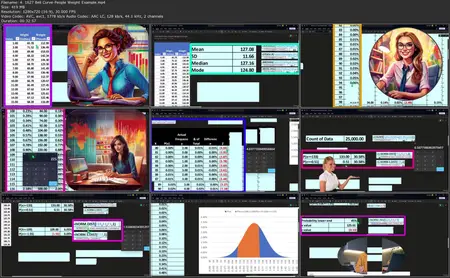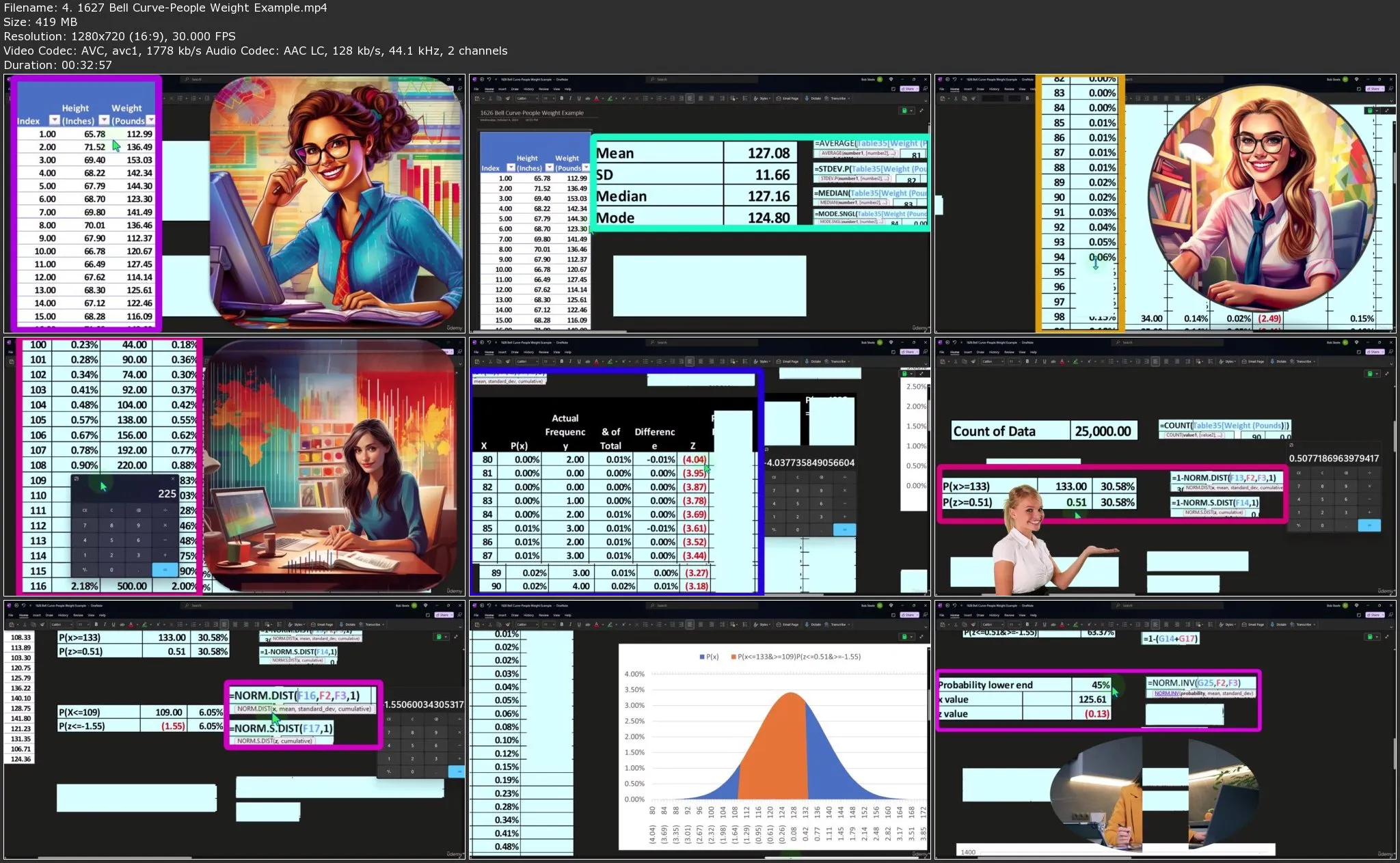Bell Curve
.MP4, AVC, 1280x720, 30 fps | English, AAC, 2 Ch | 3h 3m | 2.34 GB
Instructor: Robert (Bob) Steele
.MP4, AVC, 1280x720, 30 fps | English, AAC, 2 Ch | 3h 3m | 2.34 GB
Instructor: Robert (Bob) Steele
Exploring the Normal Distribution: Applications and Analysis Using Excel
What you'll learn
- Describe the historical development and significance of the Gaussian Distribution, tracing its origins to Carl Friedrich Gauss.
- Explain the fundamental characteristics and properties of the Normal Distribution, including its bell-shaped curve and symmetrical nature.
- Analyze areas under the curve of the Gaussian Distribution to determine probabilities and make meaningful interpretations.
- Apply the principles of the Gaussian Distribution to real-world scenarios, such as population traits, sports statistics, and outcomes in games of chance.
- Evaluate the reasons for the frequent occurrence of the Gaussian Distribution in natural and statistical phenomena.
- Utilize the Gaussian Distribution as a powerful tool for data analysis and decision-making in various fields.
- Illustrate the application of the Gaussian Distribution through practical examples and case studies.
- Synthesize knowledge of the Gaussian Distribution to solve complex statistical problems and conduct advanced data analysis.
Requirements
- Basic Mathematical Skills: A foundational understanding of basic arithmetic, algebra, and mathematical concepts.
- Introduction to Statistics: Prior exposure to basic statistical concepts such as mean, median, mode, variance, and standard deviation.
- Computer Literacy: Proficiency in using a computer for basic tasks, including file management and internet navigation.
- Data Handling Skills: Familiarity with data entry, manipulation, and basic spreadsheet functions.
- Analytical Thinking: An aptitude for logical reasoning and problem-solving.
Description
Embark on a comprehensive and in-depth journey into the fascinating world of the Gaussian or Normal Distribution, a cornerstone of statistical analysis and a critical tool for researchers, scientists, and analysts across diverse domains. This course, meticulously crafted for undergraduate students and professionals alike, unveils the layers of the Gaussian Distribution, elucidating its foundational role, intrinsic properties, and multifaceted applications.
Tracing the historical footsteps of the great mathematician Carl Friedrich Gauss, we explore his groundbreaking work and the subsequent emergence of the Gaussian Distribution as a pivotal tool in statistical studies. From predicting the position of celestial bodies to its modern-day applications in quality control and finance, the course paints a vivid picture of the distribution's significance and evolution.
Dive deep into the characteristics and properties of the Normal Distribution, learning to navigate its bell-shaped curve and symmetrical nature. Understand the critical roles of mean and standard deviation, and how they shape and define the distribution. Delve into the specifics of the Standard Normal Distribution, mastering the use of z-scores for standardizing and interpreting data.
Explore the intricacies of areas under the curve, and how they translate into probabilities and meaningful interpretations. The course provides a robust understanding of why the Gaussian Distribution arises so frequently in nature and statistics.
Through a myriad of practical examples, from the distribution of physical traits in populations to the analysis of sports statistics and outcomes in games of chance, the course demonstrates the ubiquity of the Gaussian Distribution.
This course is not just a statistical endeavor; it is a journey of discovery, insight, and application. It empowers students and professionals to not just understand the Gaussian Distribution but to wield it as a powerful tool in their analytical arsenal.
Who this course is for:
- Data Analysts: Professionals who analyze data and need a stronger grasp of the Gaussian Distribution to enhance their analyses.
- Researchers: Academics and scientists who require robust statistical methods to validate their hypotheses and research findings.
- Business Professionals: Individuals in business roles such as marketing, finance, and operations who use data to inform decision-making and strategy.
- Students: Learners in higher education pursuing degrees in fields such as data science, economics, psychology, sociology, and other disciplines where data analysis is essential.
- Aspiring Data Scientists: Those looking to build a career in data science and need foundational skills in statistical analysis and the Gaussian Distribution.
- Educators: Teachers and educators seeking to enhance their statistical knowledge and teaching techniques.
- Anyone Interested in Data Analysis: Individuals with a curiosity about data and its applications, seeking to acquire practical skills in understanding and interpreting the Gaussian Distribution.





